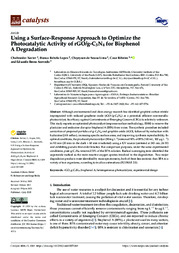Using a Surface-Response Approach to Optimize the Photocatalytic Activity of rGO/g-C3N4 for Bisphenol A Degradation.
Using a Surface-Response Approach to Optimize the Photocatalytic Activity of rGO/g-C3N4 for Bisphenol A Degradation.
Author(s): XAVIER, C.; LOPES, B. R.; LIMA. C. S.; RIBEIRO, C.; AZEVEDO, E. B.
Summary: Although environmental and clean energy research has identified graphitic carbon nitride impregnated with reduced graphene oxide (rGO/g-C3N4 ) as a potential, efficient non-metallic photocatalyst, its efficacy against Contaminants of Emerging Concern (CECs) is relatively unknown. This study reports an optimized photocatalyst (response surface methodology, RSM) to remove the plasticizer and endocrine disruptor bisphenol A (BPA) from water. The synthetic procedure included sonication of prepared particles of g-C3N4 and graphite oxide (rGO), followed by reduction with hydrazine (24 h reflux), increasing specific surface areas, and improving synthesis reproducibility. In optimal conditions, the produced photocatalyst (50 mg L?1) removed 90% of BPA (100 mL, 100 µg L−1) in 90 min (30 min in the dark + 60 min irradiated) using a UV source (centered at 365 nm, 26 W) and exhibiting pseudo-first-order kinetics. For comparison purposes, under the same experimental conditions, pure g-C3N4 removed 50% of the BPA solution. Radical scavenging tests identified the superoxide radical as the main reactive oxygen species involved in the degradation. Two major degradation products were identified by mass spectrometry, both of them less ecotoxic than BPA to a variety of test organisms, according to in silico estimations (ECOSAR 2.0).
Publication year: 2023
Types of publication: Journal article
Unit: Embrapa Instrumentation
Keywords: G-C3N4, Heterogeneous photocatalysis, RGO
Observation
Some of Embrapa's publications are published as ePub files. To read them, use or download one of the following free software options to your computer or mobile device. Android: Google Play Books; IOS: iBooks; Windows and Linux: Calibre.
Access other publications
Access the Agricultural Research Database (BDPA) to consult Embrapa's full library collection and records.
Visit Embrapa Bookstore to purchase books and other publications sold by Embrapa.

